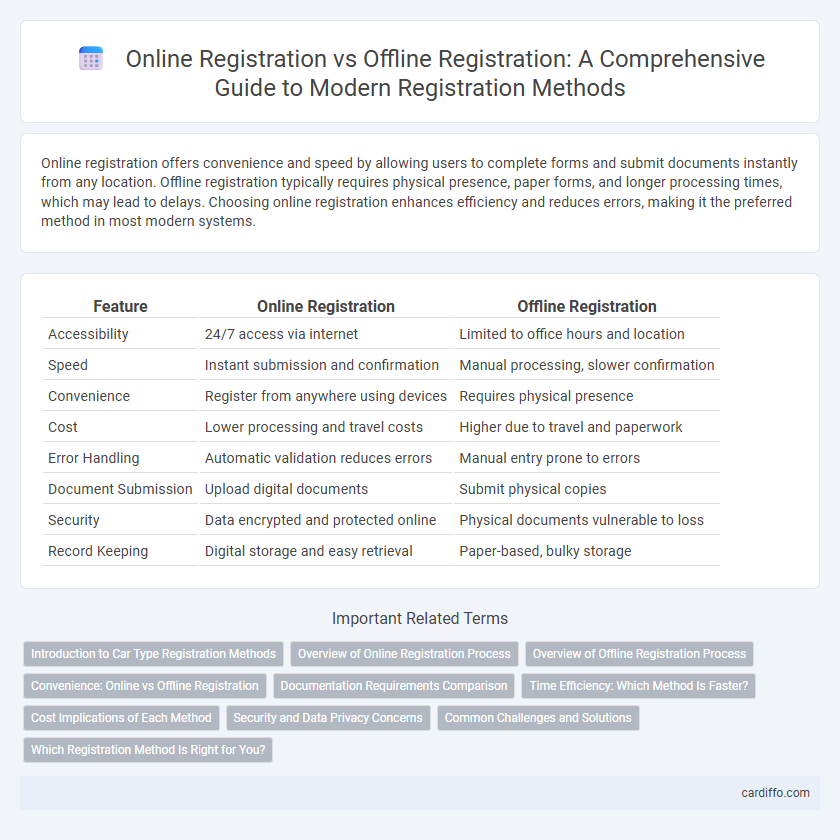Online registration offers convenience and speed by allowing users to complete forms and submit documents instantly from any location. Offline registration typically requires physical presence, paper forms, and longer processing times, which may lead to delays. Choosing online registration enhances efficiency and reduces errors, making it the preferred method in most modern systems.
Table of Comparison
| Feature | Online Registration | Offline Registration |
|---|---|---|
| Accessibility | 24/7 access via internet | Limited to office hours and location |
| Speed | Instant submission and confirmation | Manual processing, slower confirmation |
| Convenience | Register from anywhere using devices | Requires physical presence |
| Cost | Lower processing and travel costs | Higher due to travel and paperwork |
| Error Handling | Automatic validation reduces errors | Manual entry prone to errors |
| Document Submission | Upload digital documents | Submit physical copies |
| Security | Data encrypted and protected online | Physical documents vulnerable to loss |
| Record Keeping | Digital storage and easy retrieval | Paper-based, bulky storage |
Introduction to Car Type Registration Methods
Car type registration methods vary significantly between online and offline systems, offering distinct advantages for vehicle owners. Online registration streamlines the process through digital platforms, enabling users to submit documents, pay fees, and track application status without physical visits. Offline registration requires in-person visits to local transportation offices, allowing direct interaction with officials but often involving longer processing times and paperwork.
Overview of Online Registration Process
The online registration process offers a streamlined and efficient method for users to enroll by filling out digital forms accessible via websites or mobile apps, eliminating the need for physical paperwork. Key steps include account creation, form submission, document uploads, and secure payment processing, all managed through automated systems that enhance accuracy and speed. This process allows instant confirmation and real-time updates, improving user convenience compared to traditional offline registration methods.
Overview of Offline Registration Process
Offline registration involves physically visiting a designated registration center or office to complete the necessary paperwork manually. This process typically requires submitting identification documents, filling out forms by hand, and waiting in queues, leading to longer processing times compared to online methods. Despite being time-consuming, offline registration ensures direct human interaction and immediate verification of documents for accurate record-keeping.
Convenience: Online vs Offline Registration
Online registration offers unparalleled convenience by allowing users to complete the process anytime and anywhere using digital devices, eliminating the need for physical presence. Offline registration requires visiting specific locations and adhering to limited office hours, which can lead to time constraints and potential delays. The digital nature of online registration ensures faster data processing and immediate confirmation, significantly enhancing user experience compared to manual offline methods.
Documentation Requirements Comparison
Online registration typically requires digital copies of documents such as identification proofs, address verification, and recent photographs uploaded through secure portals, ensuring faster processing and immediate verification. Offline registration demands physical submission of original documents or notarized copies, often leading to longer processing times due to manual verification. The efficiency and convenience of online documentation minimize errors and reduce the need for multiple visits compared to the traditional offline process.
Time Efficiency: Which Method Is Faster?
Online registration significantly reduces processing time by allowing instant data submission and automated confirmation, eliminating the need for physical paperwork and manual entry. Offline registration often involves longer waiting periods due to in-person visits, form handling, and staff processing. Studies show online systems can cut registration time by up to 70%, making them the faster and more efficient choice.
Cost Implications of Each Method
Online registration significantly reduces administrative costs by eliminating the need for physical paperwork, postage, and manual data entry, resulting in streamlined processes and faster confirmation. Offline registration incurs higher expenses due to staff hours required for handling forms, printing materials, and potential errors in data transcription. Overall, online registration offers cost-efficiency and scalability that offline methods typically cannot match.
Security and Data Privacy Concerns
Online registration systems often utilize encrypted data transmission and multi-factor authentication to enhance security and protect user information, minimizing risks of data breaches. In contrast, offline registration typically involves physical forms prone to misplacement or unauthorized access, increasing vulnerabilities related to data privacy. Implementing strict access controls and secure storage methods is crucial for both methods to safeguard sensitive personal data effectively.
Common Challenges and Solutions
Online registration often faces challenges such as technical glitches, slow internet connectivity, and cybersecurity concerns, while offline registration struggles with data errors, physical document handling, and time-consuming manual processes. Solutions for online systems include server optimization, encryption protocols, and user-friendly interfaces, whereas offline methods benefit from digitizing records, staff training, and standardized verification procedures. Both systems require robust data management and clear communication channels to enhance accuracy and user experience during the registration process.
Which Registration Method Is Right for You?
Online registration offers convenience, faster processing, and instant confirmation, ideal for tech-savvy users and large-scale events. Offline registration provides personal interaction and can be preferable for those without reliable internet access or who need assistance with the process. Evaluating your tech comfort level, event size, and accessibility needs will help determine the most suitable registration method.
Online Registration vs Offline Registration Infographic

 cardiffo.com
cardiffo.com